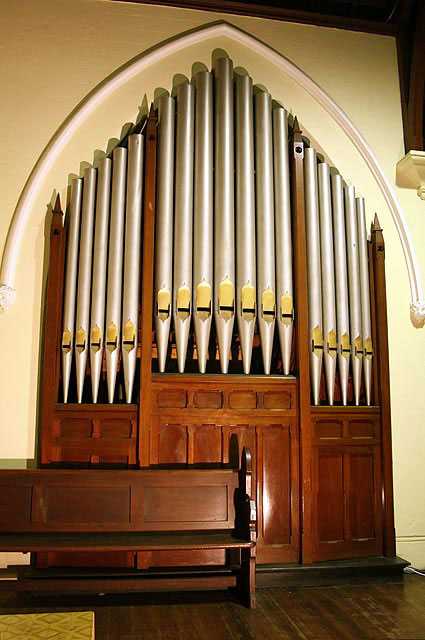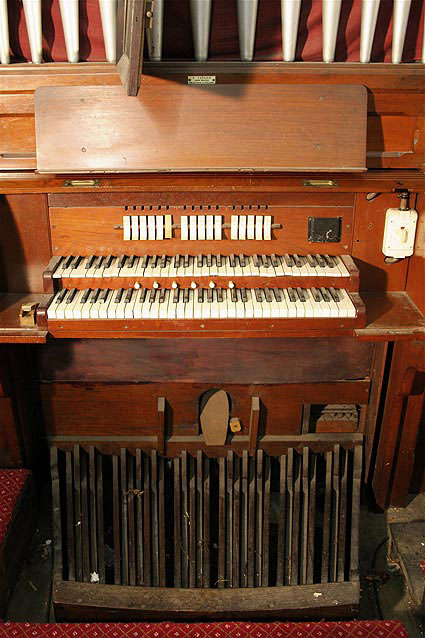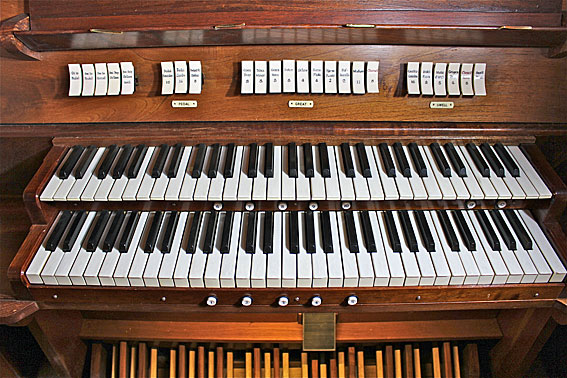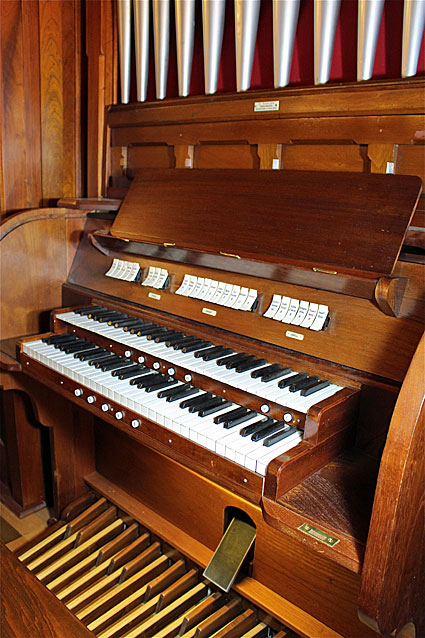
Lovat Chapel (former St Augustine's Catholic Church), Yass
[Photograph by Trevor Bunning (2017)]

Lovat Chapel (former St Augustine's Catholic Church), Yass
[Photograph by Trevor Bunning (2017)]
Historical and Technical Documentation by Geoffrey Cox © OHTA 2018 (last updated July 2018)
The foundation stone of a proposed Catholic church in Yass was blessed by Bishop Polding on 27 August 1838, and the nave of the first St Augustine's church (now Lovat Chapel) was blessed on 14 February 1844.1 With the addition of a new chancel, gallery, tower and spire, the enlarged church was blessed on 9 September 1860,2 and then re-opened after further improvements on 20 January 1889.3 The Sisters of Mercy, who arrived in the parish in 1875, took over the old church as a convent chapel in 1956 (when the new church was built across the road), taking down the spire and replacing the original gallery.4
The adjacent Mount Carmel College was closed at the end of 2014, and a heritage grant from the NSW Government in October 2017 contributed to the restoration of the former convent building (renamed the 'Hartigan Centre') for cultural purposes, especially as a centre for music teaching.5 The old church has been re-named the 'Lovat Chapel' in honour of Father Charles Lovat, founder of the Yass mission in the 1840s, who instigated the building of the church.6

The Frederick Taylor organ in the Lovat Chapel
[Photograph by Trevor Bunning (May 2018)]
The organ installed in the Lovat Chapel in 2018 was built by Frederick Taylor of Melbourne in 1912 for the Methodist Church, Ashfield, NSW. It was described by John Stiller as 'the only unaltered example of Taylor's work in New South Wales [and]. . . a rare Australian example of a Taylor organ which remains unaltered.'7

Frederick Taylor's nameplate on the Ashfield organ
[Photograph by Trevor Bunning (October 2007)]
Frederick Taylor (1861-1938) worked initially for George Fincham in Melbourne, but commenced his own business in April 1900.8 The tonal design of Taylor's earlier instruments was conservative, but from around 1910 he developed a distinctive symphonic style, using tubular-pneumatic action, increased wind pressures, an emphasis on colourful unison stops (often tapered), the use of superlative spotted-metal pipework by A. Palmer & Sons of London, and a reliance on octave couplers for brilliance. John Maidment has attributed aspects of Taylor's symphonic style to American influence:
Taylor's organ building style was remarkably avant-garde for the time: the influences are difficult to determine in the absence of archival material. He was certainly influenced by tonal practices in the United States and utilised mechanical components imported from the United States, unlike any other Australian organ builder of the period, where allegiances to Britain were strong.9
Other examples of Taylor's organs exhibiting his symphonic design are few and far between. Most of the surviving instruments have been altered tonally, and several, including his organ for the Presbyterian Church, North Carlton (c.1910; moved to St Barnabas' Anglican Church, Balwyn, Vic. in 1960), have been broken up. Apart from the Ashfield instrument (1912), some evidence of Taylor's symphonic style survives in his organs for the Uniting (formerly Methodist) Church, Armadale, Vic (1912-14), and the Methodist Church, Port Adelaide, SA (1912; moved to Immanuel Lutheran Church, Gawler, SA in 1974).
The specification of the Ashfield organ, as recorded by John Stiller, was as follows:
| Great Open Diapason Tibia Minor Gemshorn Dolce Harmonic Flute Swell Contra Gamba Hohl Flöte Viol d'Orchestre Geigen Principal Closed Horn Tremulant Pedal Bourdon Flute Dolce Couplers Swell to Great Swell Super Octave Great to Pedal Swell to Pedal |
8 8 8 8 4 16 8 8 4 8 16 8 |
[Compass: 61/32]
674 pipes
Pitch a=427 Hz at 15 degrees Celsius
Tubular-pneumatic action.10
The concave wooden stopkeys, faced with white bakelite (or some other plastic material) and using a distinctive style of lettering, were similar to those used by Taylor on other organs of the period:



Stopkey rail at the Uniting Church, Ashfield, NSW (1912)
[Photographs by Trevor Bunning (October 2007)]

Stopkey rail from the Presbyterian Church, North Carlton, Vic (c.1910),
now the property of OHTA
[Photograph by John Maidment (August 2007)]

Stopkey rail at the Methodist Church, Armadale, Vic (1912-14)
[Photograph by John Maidment (November 2010)]
The Wesleyan Church at Ashfield had been opened in May 1865.11 The chancel, organ chamber and vestries were added in 1912, at which time the new organ by Frederick Taylor was completed. The instrument was dedicated on Sunday 1 September, and described as follows:
The organ has also been completed at a cost, including motor power and accessories, of between £500 and £600, and is claimed by its builder and designer to be a unique instrument, built on the builder 's latest Tubular Pneumatic system, including couplers and draw stop action and his patents for stop control and ad libitum pedals.12

The Uniting (formerly Methodist) Church, Ashfield, NSW
[Photograph by Trevor Bunning (October 2007)]
The organ chamber was to the left of the chancel, with the bass of the Great Open Diapason forming the façade in the transept. The Swell was placed behind the Great and the Pedal behind the Swell. The console was effectively on the side of the organ, with the Pedal Flute Dolce 8ft forming the façade above the console in the chancel.


The Taylor organ in its location at Ashfield
[Photographs by Trevor Bunning (October 2007)]

The façade of the organ in the transept,
containing the bass of the Open Diapason
[Photograph by Trevor Bunning (October 2007)]

Console of the Taylor organ at Ashfield
[Photograph by Trevor Bunning (October 2007)]
This arrangement necessitated long tube runs, and there were problems with the action from the outset. Kelvin Hastie reported that the organ was mostly playable in 1977 when he first saw it, but that it was subsequently left unplayed and neglected for several decades:
The church received a quote from [Ian] Brown to rebuild the organ in 1977, but as it was too expensive, they opted for an electronic and left the pipe organ sitting there. I was quite surprised when I revisited the church in 1983 to find that some 6 years after the last professional visit, it still mostly worked – all but 2 of the key actions and all the stops played. The blower has since been disconnected. The principal problem was with the pedal. I think the chest end is quite good, but the tubing at the back of the console is haphazard and poorly repaired by [S.T.] Noad.13





Dilapidated pipework and action of the Taylor organ at Ashfield
[Photographs by Trevor Bunning (October 2007)]
The church's Trust Minute books record constant problems with the organ, even in the first few decades at Ashfield. By 2006 it had become completely unplayable.14
The space occupied by the disfunctional organ was considered by the church authorities to be more useful as a meeting room for the charity known as the 'Exodus Foundation', which had become the focus of the congregation by this time. A number of organbuilders had been made aware of the organ's possible demise, but none was able to provide storage space or suggest a new home for the instrument.15
On the basis of its exceptional symphonic tonal design and as a rare surviving example of Taylor's work, a proposal was developed in 2007 for the organ to be acquired by the National Museum of Australia, but this did not eventuate.16
The organ was consequently entrusted in 2008 to Trevor Bunning, who had it transported to Canberra, where the project to rebuild and re-locate it would be spread over the next ten years.
After much uncertainty, the refurbished chapel in Yass was identified in 2017 as a suitable home for the instrument. The chapel's excellent reverberant acoustic was already raising its profile as a venue for music making, and the establishment of the adjacent Hartigan Centre in the former convent building has placed the organ in a strong environment for music-teaching.17
The organ was installed in its present location during the first half of 2018.

Trevor Bunning and Owen Jones during the installation of the organ
[Photograph by Mike Leys (March 2018)]
Space constraints in the gallery dictated that the original configuration of the organ could not be retained. The Great and Swell are now placed side-by-side, with the Swell on the left and the Great on the right. The problematic original tubular-pneumatic action was abandoned in favour of modern electro-magnetic action, with technical support from Owen Jones, Australian agent for Artisan Instruments Inc, USA.18

Trevor Bunning's Gallery plan, showing the internal layout of the organ
[Trevor Bunning Architects, Nicholls, ACT, April 2018]
Early assistance came from Roger Jones of Adelaide, who repaired many damaged pipes, refaced the manuals and pedals, and made three new single-rise bellows as well as the pipes for a new Fifteenth 2ft rank. After Jones' death in 2014, Campbell Hargraves of Melbourne restored the original Great slider chest, and made a new two-rank slider chest, grafted to the original Great chest to accommodate additional ranks.19 He was also involved in regulating and tuning the organ in its new location.
As the Ashfield church had insisted on keeping the transept façade (to comply with "building heritage requirements"), it was necessary to find sixteen replacement pipes for the bass of the Great Open Diapason 8ft. These were sourced from the estate of Anthony Welby, and are believed to have come from the 1941 Whitehouse Bros organ at St James' Anglican Church, Turramurra. There were seventeen pipes in the original façade at Ashfield (pictured earlier), but one was non-speaking.20 Both the Ashfield pipes and the Turramurra pipes were made by A. Palmer & Sons of London, and the transition between the two is reported to be seamless.

Campbell Hargraves, with Hamid Haidir and Faisal Ali
(Hazara refugees who have escaped persecution in Quetta, Pakistan),
standing next to the substitute Open Diapason bass pipes
[Photograph by Trevor Bunning (May 2014)]
Two additional ranks have been added to the Great: the Principal 4ft, containing Palmer pipes that were added by S.T. Noad to the 1941 Whitehouse at St James' Turramurra, and the Fifteenth 2ft rank, made by Roger Jones to fit the scale of the existing Taylor pipework.

Pipework of the Great Organ during restoration in Canberra,
showing the additional Principal 4ft and Fifteenth 2ft in the foreground
[Photograph by Trevor Bunning (February 2016)]
Console fittings were retained where practicable. Unfortunately, the original stop keys (pictured earlier) were faced with a very brittle white bakelite (or some other plastic material) and could not be mended or replaced. The current stopkeys, sourced by Roger Jones from an earlier organ in Adelaide, have a similar concave profile but are made from solid ivory.21 They have been re-engraved by Jones using a font style to match that used by Taylor.

The restored keyboards and re-cycled stopkeys,
sourced and re-engraved by Roger Jones
[Photograph by Trevor Bunning (May 2018)]

The restored cedar console
[Photograph by Trevor Bunning (May 2018)]
The final specification, which includes preparation at the console for three further stops, is as follows:
| Great Division Open Diapason Tibia Minor Gemshorn Dolce Harmonic Flute Octave Fifteenth Harmonic Piccolo Mixture Clarinet Swell Division Contra Gamba Hohl Flute Viol d'Orchestre Geigen Principal Closed Horn Swell Tremulant Pedal Division Bourdon Contra Gamba Flute Dolce Couplers Great to Pedal Swell to Pedal Swell to Great Swell Super Octave Swell Super Octave to Great |
8 8 8 8 4 4 2 2 II 8 16 8 8 4 8 16 16 8 |
(61 note slider chests) [2018] [2018] [prepared for at console] [prepared for at console] [prepared for at console] (61 note slider chests) (32 note compass, pedals concave radiating) [borrowed from Swell, 2018] |
General
10 Divisional/general combination pistons
1 Sforzando piston
1 General cancel piston
Electric action balanced swell pedal
Key action: generally electric
Stop action: electric
Façade pipes: zinc (speaking).
Casework: polished Australian Cedar throughout
Console: casework polished Aus. Cedar
Stop tabs: solid engraved ivory
Currently 796 pipes
Pitch: a = 440 Hz approx.22

The organ completed in the gallery of the Lovat Chapel, Yass
[Photograph by Mike Leys (May 2018)]
A 'Preview Recital' by Samuel Giddy was presented on Sunday 1 July 2018, followed by opening celebrations between Friday 24 and Sunday 26 August.
_________________________________________________________________
1 Sydney Chronicle (March 1844), cited in Brian Mayer, Memories of Yass Mission: St. Augustine's Parish, Yass, New South Wales. Sesquicentenary 1938-1988 (St Augustine's Parish Sesquicentenary Committee, 1988), pp. 5, 23.
2 Yass Courier (15 September 1860), cited in Mayer, p. 24; see also: The Freeman's Journal (19 September 1860), p. 1.
3 Mayer, p. 27.
4 Mayer, pp. 28, 31-32.
5 Toby Vue, "Hartigan Centre to be restored for cultural activities," Yass Tribune (23 October 2017).
6 Mayer, p. 18.
7 John Stiller, Uniting Church, Ashfield, NSW: Detailed Documentation of Pipe Organ built by Frederick Taylor 1912 (Camberwell: OHTA, July 1983).
8 Graeme Rushworth, Historic Organs of New South Wales (Sydney: Hale & Iremonger, 1988), p 196.
9 John Maidment, Comments concerning the preservation the Ashfield Taylor organ (2007), reproduced in Trevor Bunning, "Historic Organ Rescued and Reborn," The Sydney Organ Journal, vol. 49, no. 3 (Winter 2018), p. 34.
10 Specification from John Stiller, op. cit., reproduced in Kelvin Hastie, "The Destruction of Diversity: Lost Sounds - Part II," The Sydney Organ Journal, vol. 37, no. 4 (Spring 2006), p. 58.
11 The Empire, Sydney (25 May 1865), p. 5.
12 "Ashfield Church: Additions and New Organ," The Methodist (31 August 1912), p. 9.
13 Personal correspondence to Trevor Bunning from Kelvin Hastie, 14 October 2007.
14 Kelvin Hastie, op. cit., pp. 57-58.
15 Bunning, p. 32.
16 Maidment, op. cit.
17 Personal communication to G. Cox from Trevor Bunning, 9 October 2017.
18 Bunning, p. 36.
19 Bunning, pp. 36-37.
20 Personal communication to G. Cox from Trevor Bunning, 17 May 2018.
21 Personal communication to G. Cox from Trevor Bunning, 9 October 2017.
22 Specification supplied by Trevor Bunning, October 2017.